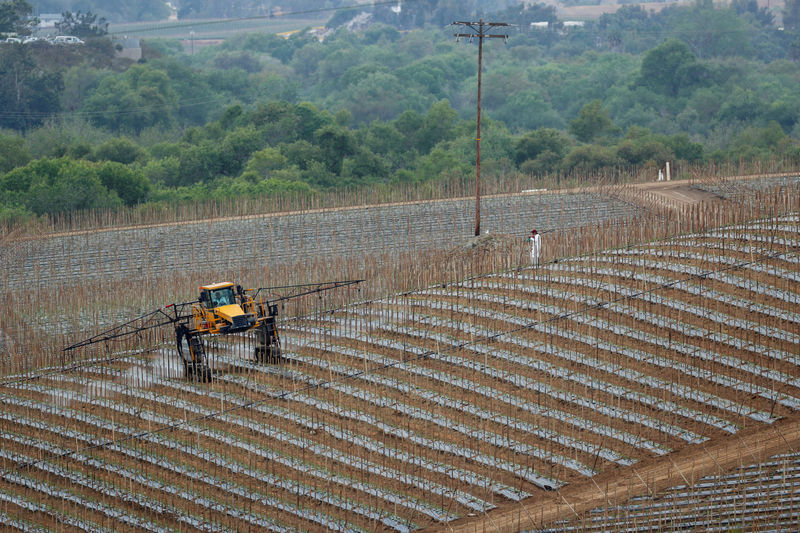 © Reuters. Workers spray a hillside of newly planted tomatoes in Bonsall, California
© Reuters. Workers spray a hillside of newly planted tomatoes in Bonsall, CaliforniaBy P.J. Huffstutter
CHICAGO (Reuters) – The U.S. Department of Agriculture (USDA) dropped its net farm income forecast for 2019 by more than 10 percent on Wednesday, saying that data lags from the partial government shutdown failed to show the full picture of the sector’s health.
The good news: net farm income is forecast to reach $69.4 billion in 2019, up 10 percent from last year, in part because production costs are stabilizing and farmers are expected to earn more when selling off their crops and livestock, the agency said.
Net farm income, as calculated by USDA, includes the value of crops and other commodities that farmers have in storage, among other things.
Last month, USDA projected that net farm income would hit $77.6 billion in 2019 – the highest total since a global glut in grains sent commodity prices falling over the past five years.
That forecast, however, was based on older data and was far less detailed because of the 35-day partial federal government shutdown, which ended Jan. 25. Wednesday’s farm income report was originally set for a Feb. 6 release.
Agency economists used different methods to forecast farm income than in last month’s report, which did not include data from a monthly global supply and demand report issued in February, said Carrie Litkowski, a senior economist and team leader at USDA’s Economic Research Service.
Commercial farmers’ balance sheets are expected to remain strong overall this year, even though debt levels for the farm sector are expected to be the highest since 1982, Litkowski said.
While farm economy’s profits are expected to be stronger this year, the rise in net income is not enough to completely offset the sour incomes from 2018, when the U.S.-China trade war sent crop prices skidding.
Market Facilitation Program trade aid payments are forecast to be $5.2 billion in 2018 and $3.5 billion in 2019.
Another note of caution: slightly higher production expenses and lower federal government payments to farmers will temper the growth in overall income for the year, the agency said.
Still, prices are expected to rise in both crops and livestock commodities, resulting in higher cash receipts – with total cash receipts expected to increase more than 8 percent in 2019 over the previous year, the agency said.
Corn is expected to be among the top winners in fattening cash receipts, up 5.2 percent in 2019, due to higher prices, the agency said. But soybean cash receipts are expected to drop by 6.6 percent year over year, reflecting forecasts of lower prices and less volume sold.
Fusion Media or anyone involved with Fusion Media will not accept any liability for loss or damage as a result of reliance on the information including data, quotes, charts and buy/sell signals contained within this website. Please be fully informed regarding the risks and costs associated with trading the financial markets, it is one of the riskiest investment forms possible.
Source: Investing.com






























